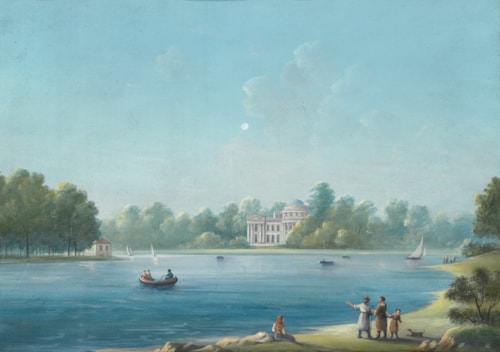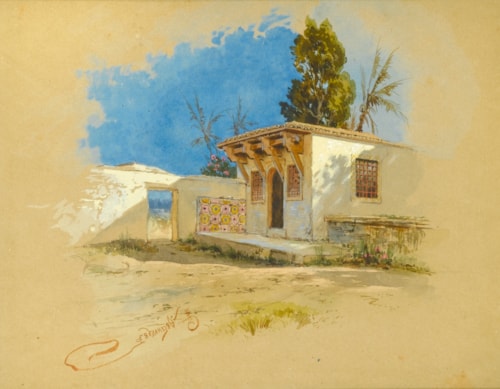oseph Josefovich Charlemagne
(St. Petersburg 1824 - St. Petersburg 1870)
Ice Fair on the Neva River, St. Petersburg
signed and dated ‘Josef CHARLEMAGNE 1860’ (lower right)
gouache and paper
29.5 x 40 cm (11½ x 15⅝ in)
In this bustling winter watercolour, Joseph Josefovich Charlemagne depicts the residents of St. Petersburg congregated on the frozen River Neva during the winter of 1860. The Neva is an essential part of St. Petersburg’s geography and aesthetic allure. Originally, the river acted as the main street of the city. Throughout most of the eighteenth century there were no bridges across it, instead people were ferried from one bank to the other in just the way Peter the Great (1672-1725) had intended when he founded his ‘Venice of the North’. The Neva River is just over forty-six miles long, flowing from the Lake Ladoga to the Gulf of Finland, in the eastern part of the Baltic Sea. Before joining the Baltic, it splits into several branches forming a delta, where downtown St. Petersburg is located. On average the river is between 1,300 and 2,000 feet wide, but where it flows between the Peter and Paul fortress and the bank of the Hermitage it exceeds 2,600 feet. The Neva is frozen between mid December and early April, rendering navigation impossible in this period.
The background of this picture shows a dramatic and sweeping vista of St. Petersburg, and Charlemagne’s delicate use of white heightening on the buildings suggests a recent dusting of snow. From the left-hand side the edges of the Winter Palace and the Hermitage briefly appear, followed by the gilded steeple of the Russian Admiralty tower, built between 1806 and 1823, and the magnificent dome of St. Isaac’s Cathedral, that had only opened to the public two years previously, in 1858. On the far right-hand side one discerns the heroic, rock-mounted equestrian statue of Peter the Great.
In the foreground, Charlemagne shows the people of St. Petersburg partaking in a variety of social activities on the ice, whilst abandoned boats, rendered obsolete by the swathe of ice and snow, are scattered along the riverside. A large choom tent, a faint glow radiating from within, has been erected and a large number of people are gathered around it. The large sign posted outside suggests this could be an official meeting place. In the centre, surrounded by small groups of people conversing and children playing, four reindeer harnessed to a small sleigh await their driver. The intended purpose of this sleigh becomes clear on the far right-hand side as two carts chase each other at great speed towards a large huddle of bystanders.
Charlemagne, brother of the History painter Adolphe Josefovich Charlemagne, studied at the Imperial Academy of Arts under Alexandr Pavlovich Bryullov (1798-1877) and graduated in 1846. He subsequently worked as an architectural assistant, and was awarded in 1850 by the Academy the title of ‘Artist of the First Degree’ for his architectural drawings, and in 1857 that of ‘Academician for Architecture’. However, it was his watercolours, more than his work as a draughtsman and architect, which earned him the greatest public recognition, and led him to execute commissions for the Grand Duchess Olga Feodorovna (1839-1891) among others. The precision with which the buildings are depicted in this painting, coupled with the flawless perspective, testify none the less to Charlemagne’s gift for architectural composition.
Fresh Water / Água Doce Gaiás Centre Museum, Santiago de Compestela, March - September 2014.
In this bustling winter watercolour, Joseph Josefovich Charlemagne depicts the residents of St. Petersburg congregated on the frozen River Neva during the winter of 1860. The Neva is an essential part of St. Petersburg’s geography and aesthetic allure. Originally, the river acted as the main street of the city. Throughout most of the eighteenth century there were no bridges across it, instead people were ferried from one bank to the other in just the way Peter the Great (1672-1725) had intended when he founded his ‘Venice of the North’. The Neva River is just over forty-six miles long, flowing from the Lake Ladoga to the Gulf of Finland, in the eastern part of the Baltic Sea. Before joining the Baltic, it splits into several branches forming a delta, where downtown St. Petersburg is located. On average the river is between 1,300 and 2,000 feet wide, but where it flows between the Peter and Paul fortress and the bank of the Hermitage it exceeds 2,600 feet. The Neva is frozen between mid December and early April, rendering navigation impossible in this period.
The background of this picture shows a dramatic and sweeping vista of St. Petersburg, and Charlemagne’s delicate use of white heightening on the buildings suggests a recent dusting of snow. From the left-hand side the edges of the Winter Palace and the Hermitage briefly appear, followed by the gilded steeple of the Russian Admiralty tower, built between 1806 and 1823, and the magnificent dome of St. Isaac’s Cathedral, that had only opened to the public two years previously, in 1858. On the far right-hand side one discerns the heroic, rock-mounted equestrian statue of Peter the Great.
In the foreground, Charlemagne shows the people of St. Petersburg partaking in a variety of social activities on the ice, whilst abandoned boats, rendered obsolete by the swathe of ice and snow, are scattered along the riverside. A large choom tent, a faint glow radiating from within, has been erected and a large number of people are gathered around it. The large sign posted outside suggests this could be an official meeting place. In the centre, surrounded by small groups of people conversing and children playing, four reindeer harnessed to a small sleigh await their driver. The intended purpose of this sleigh becomes clear on the far right-hand side as two carts chase each other at great speed towards a large huddle of bystanders.
Charlemagne, brother of the History painter Adolphe Josefovich Charlemagne, studied at the Imperial Academy of Arts under Alexandr Pavlovich Bryullov (1798-1877) and graduated in 1846. He subsequently worked as an architectural assistant, and was awarded in 1850 by the Academy the title of ‘Artist of the First Degree’ for his architectural drawings, and in 1857 that of ‘Academician for Architecture’. However, it was his watercolours, more than his work as a draughtsman and architect, which earned him the greatest public recognition, and led him to execute commissions for the Grand Duchess Olga Feodorovna (1839-1891) among others. The precision with which the buildings are depicted in this painting, coupled with the flawless perspective, testify none the less to Charlemagne’s gift for architectural composition.
Fresh Water / Água Doce Gaiás Centre Museum, Santiago de Compestela, March - September 2014.





 contact
contact contact
contact +44 20 7313 8040
+44 20 7313 8040









